engine BUICK RANDEZVOUS 2007 Owner's Guide
[x] Cancel search | Manufacturer: BUICK, Model Year: 2007, Model line: RANDEZVOUS, Model: BUICK RANDEZVOUS 2007Pages: 528, PDF Size: 2.99 MB
Page 195 of 528

To adjust the HUD so you can see it properly, do
the following:
1. Start your engine and turn the dimmer knob to
the desired HUD image brightness.
The brightness of the HUD image is determined
by the ambient light conditions in the direction
your vehicle is facing and where you have the
HUD dimmer knob set. If you are facing a dark
object or a heavily shaded area, your HUD may
anticipate that you are entering a dark area and
may begin to dim.
2. Adjust the driver’s seat. If you change your
seat position, you may have to readjust
your HUD.3. Press the UP or DN buttons until the HUD
image is easy to see and then press the DN
button until the HUD image is as low as
possible, but remains in full view straight
ahead near the front bumper.
The HUD image can only be adjusted up and
down, not side-to-side.
4. To turn the image off, turn the dimmer knob
counterclockwise until it stops.
If the sun comes out or it becomes cloudy, you
may need to adjust the HUD brightness again
using the dimmer knob. Polarized sunglasses
could make the HUD image harder to see.
When you �rst start the vehicle the display will
show BUICK and the Buick logo for a few seconds.
If it is cold outside, this display may stay on for
up to a minute.
Clean the inside of the windshield as needed to
remove any dirt or �lm that reduces the sharpness
or clarity of the HUD image.
195
Page 201 of 528

To change the current mode, select one of the
following:
H(Vent):This mode directs air to the instrument
panel outlets.
)(Bi-Level):This mode directs half of the air to
the instrument panel outlets, then directs the
remaining air to the �oor outlets. Cooler air
is directed to the upper outlets and warmer air to
the �oor outlets.
6(Floor):This mode directs most of the air to
the �oor outlets. Use this mode to send air to
the rear of the vehicle. Keep the area under the
front seats free of objects that could obstruct
air�ow to the rear of the vehicle.
The right knob can also be used to select defog or
defrost mode. For more information, see
“Defogging and Defrosting” later in this section.
9(Fan):Turn the left knob clockwise or
counterclockwise to increase or decrease the fan
speed. Turn the knob to 0 to turn off the fan.
The fan must be turned on for the air conditioning
compressor to operate.
@(Recirculation):This mode keeps outside air
from coming in the vehicle. It can be used to
prevent outside air and odors from entering your
vehicle or help heat or cool the air inside your
vehicle more quickly. Press this button to turn the
recirculation mode on or off. When the button
is pressed, an indicator light will come on.
The air-conditioning compressor also comes on.
The recirculation mode can be used with vent and
bi-level modes, but it cannot be used with �oor,
defog, defrost or outside air modes.
Temperature Control:Turn the center knob
clockwise or counterclockwise to increase
or decrease the air temperature inside your
vehicle.
uA/C (Air Conditioning):Press this button to
turn the air-conditioning system on or off.
When A/C is pressed, an indicator light in the
button will come on to let you know that air
conditioning is activated.
You may notice a slight change in engine
performance when the air-conditioning compressor
shuts off and turns on again. This is normal.
201
Page 202 of 528
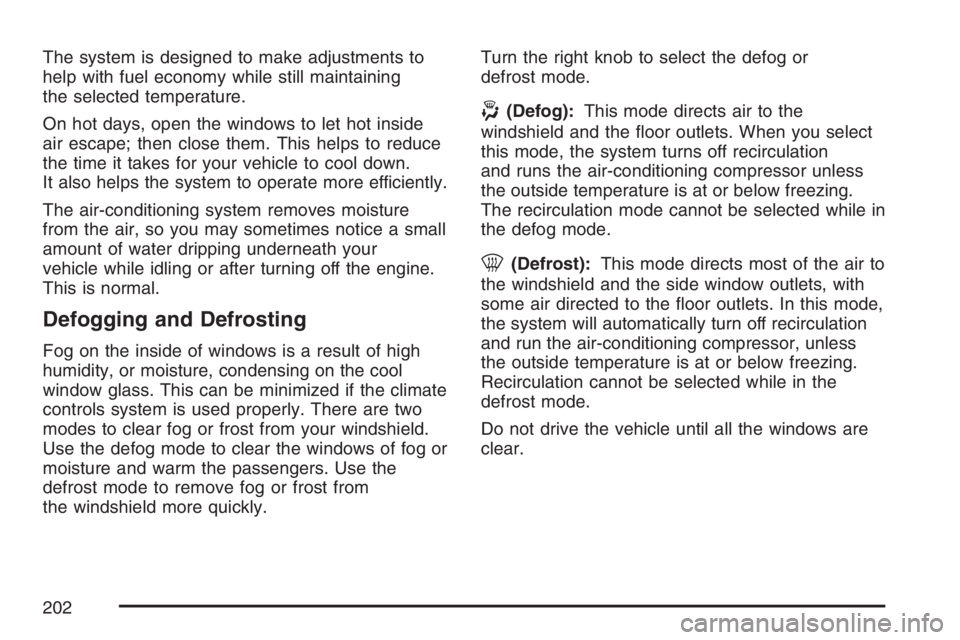
The system is designed to make adjustments to
help with fuel economy while still maintaining
the selected temperature.
On hot days, open the windows to let hot inside
air escape; then close them. This helps to reduce
the time it takes for your vehicle to cool down.
It also helps the system to operate more efficiently.
The air-conditioning system removes moisture
from the air, so you may sometimes notice a small
amount of water dripping underneath your
vehicle while idling or after turning off the engine.
This is normal.
Defogging and Defrosting
Fog on the inside of windows is a result of high
humidity, or moisture, condensing on the cool
window glass. This can be minimized if the climate
controls system is used properly. There are two
modes to clear fog or frost from your windshield.
Use the defog mode to clear the windows of fog or
moisture and warm the passengers. Use the
defrost mode to remove fog or frost from
the windshield more quickly.Turn the right knob to select the defog or
defrost mode.
-(Defog):This mode directs air to the
windshield and the �oor outlets. When you select
this mode, the system turns off recirculation
and runs the air-conditioning compressor unless
the outside temperature is at or below freezing.
The recirculation mode cannot be selected while in
the defog mode.
0(Defrost):This mode directs most of the air to
the windshield and the side window outlets, with
some air directed to the �oor outlets. In this mode,
the system will automatically turn off recirculation
and run the air-conditioning compressor, unless
the outside temperature is at or below freezing.
Recirculation cannot be selected while in the
defrost mode.
Do not drive the vehicle until all the windows are
clear.
202
Page 203 of 528

Rear Window Defogger
The rear window defogger uses a warming grid to
remove fog from the rear window.
button will come on to let you know that the
rear window defogger is activated.
The rear window defogger will turn off
approximately 10 minutes after the button is
pressed. If turned on again, the defogger will only
run for approximately �ve minutes before
turning off. The defogger can also be turned off by
pressing the button again or by turning off the
engine.
Notice:Do not use anything sharp on the
inside of the rear window. If you do, you could
cut or damage the warming grid, and the
repairs would not be covered by your warranty.
Do not attach a temporary vehicle license,
tape, a decal or anything similar to the
defogger grid.
Dual Climate Control System
Your vehicle may have a dual climate control
system. With this system you can control
the heating, cooling, and ventilation for your
vehicle.
Operation
Turn the right knob clockwise or counterclockwise
to direct the air�ow inside your vehicle.
203
Page 204 of 528

To change the current mode, select one of the
following:
H(Vent):This mode directs air to the instrument
panel outlets.
)(Bi-Level):This mode directs half of the air to
the instrument panel outlets, then directs the
remaining air to the �oor outlets. Cooler air
is directed to the upper outlets and warmer air to
the �oor outlets.
6(Floor):This mode directs most of the air to
the �oor outlets. Use this mode to send air to
the rear of the vehicle. Keep the area under the
front seats free of objects that could obstruct
air�ow to the rear of the vehicle.
The right knob can also be used to select defog or
defrost mode. For more information, see
“Defogging and Defrosting” later in this section.
9(Fan):Turn the left knob clockwise or
counterclockwise to increase or decrease the fan
speed. Turn the knob counterclockwise until it
stops to turn off the fan. The fan must be turned
on for the air conditioning compressor to operate.
@(Recirculation):This mode keeps outside air
from coming in the vehicle. It can be used to
prevent outside air and odors from entering your
vehicle or help heat or cool the air inside your
vehicle more quickly. Press this button to turn the
recirculation mode on or off. When the button
is pressed, an indicator light will come on.
The air-conditioning compressor also comes on.
The recirculation mode can be used with vent and
bi-level modes, but it cannot be used with �oor,
defog, defrost or outside air modes.
Temperature Control:Use the driver’s and
passenger’s temperature levers to increase or
decrease the air temperature inside your vehicle.
uA/C (Air Conditioning):Press this button
to turn the air-conditioning system on or off. When
A/C is pressed, an indicator light in the button
will come on to let you know that air conditioning
is activated.
You may notice a slight change in engine
performance when the air-conditioning compressor
shuts off and turns on again. This is normal.
The system is designed to make adjustments to
help with fuel economy while still maintaining
the selected temperature.
204
Page 205 of 528
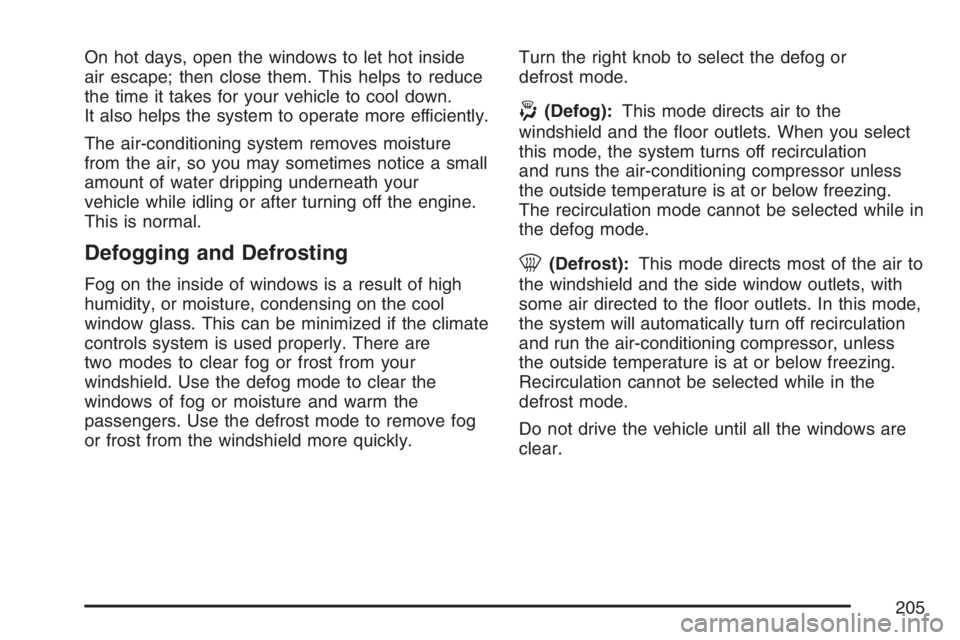
On hot days, open the windows to let hot inside
air escape; then close them. This helps to reduce
the time it takes for your vehicle to cool down.
It also helps the system to operate more efficiently.
The air-conditioning system removes moisture
from the air, so you may sometimes notice a small
amount of water dripping underneath your
vehicle while idling or after turning off the engine.
This is normal.
Defogging and Defrosting
Fog on the inside of windows is a result of high
humidity, or moisture, condensing on the cool
window glass. This can be minimized if the climate
controls system is used properly. There are
two modes to clear fog or frost from your
windshield. Use the defog mode to clear the
windows of fog or moisture and warm the
passengers. Use the defrost mode to remove fog
or frost from the windshield more quickly.Turn the right knob to select the defog or
defrost mode.
-(Defog):This mode directs air to the
windshield and the �oor outlets. When you select
this mode, the system turns off recirculation
and runs the air-conditioning compressor unless
the outside temperature is at or below freezing.
The recirculation mode cannot be selected while in
the defog mode.
0(Defrost):This mode directs most of the air to
the windshield and the side window outlets, with
some air directed to the �oor outlets. In this mode,
the system will automatically turn off recirculation
and run the air-conditioning compressor, unless
the outside temperature is at or below freezing.
Recirculation cannot be selected while in the
defrost mode.
Do not drive the vehicle until all the windows are
clear.
205
Page 206 of 528
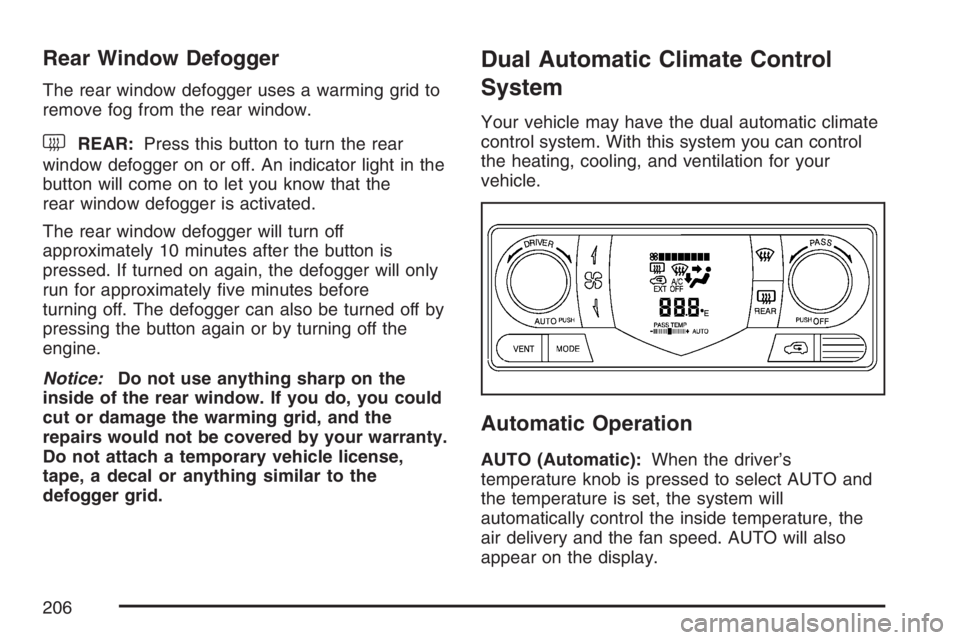
Rear Window Defogger
The rear window defogger uses a warming grid to
remove fog from the rear window.
button will come on to let you know that the
rear window defogger is activated.
The rear window defogger will turn off
approximately 10 minutes after the button is
pressed. If turned on again, the defogger will only
run for approximately �ve minutes before
turning off. The defogger can also be turned off by
pressing the button again or by turning off the
engine.
Notice:Do not use anything sharp on the
inside of the rear window. If you do, you could
cut or damage the warming grid, and the
repairs would not be covered by your warranty.
Do not attach a temporary vehicle license,
tape, a decal or anything similar to the
defogger grid.
Dual Automatic Climate Control
System
Your vehicle may have the dual automatic climate
control system. With this system you can control
the heating, cooling, and ventilation for your
vehicle.
Automatic Operation
AUTO (Automatic):When the driver’s
temperature knob is pressed to select AUTO and
the temperature is set, the system will
automatically control the inside temperature, the
air delivery and the fan speed. AUTO will also
appear on the display.
206
Page 209 of 528
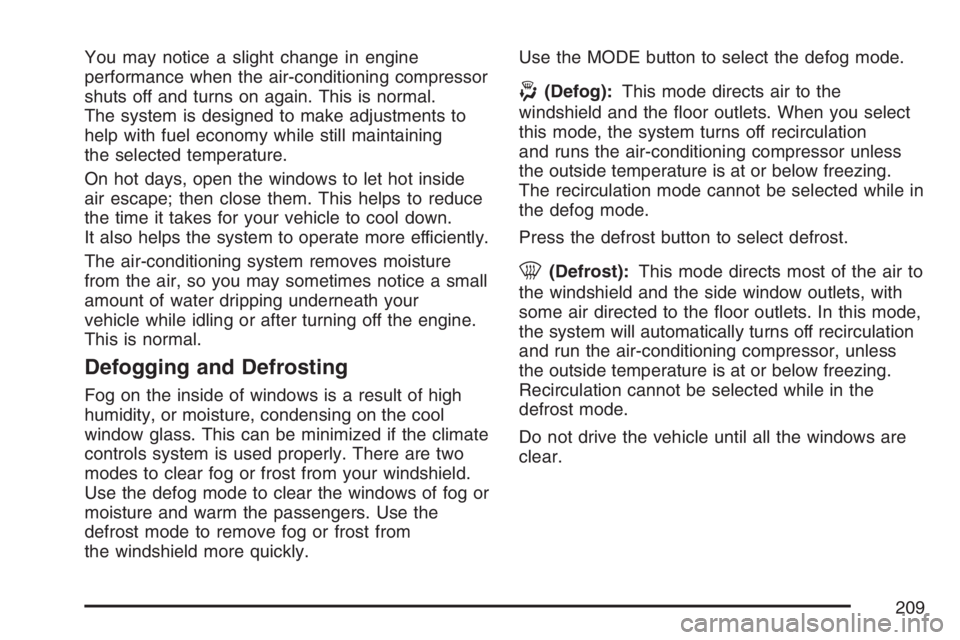
You may notice a slight change in engine
performance when the air-conditioning compressor
shuts off and turns on again. This is normal.
The system is designed to make adjustments to
help with fuel economy while still maintaining
the selected temperature.
On hot days, open the windows to let hot inside
air escape; then close them. This helps to reduce
the time it takes for your vehicle to cool down.
It also helps the system to operate more efficiently.
The air-conditioning system removes moisture
from the air, so you may sometimes notice a small
amount of water dripping underneath your
vehicle while idling or after turning off the engine.
This is normal.
Defogging and Defrosting
Fog on the inside of windows is a result of high
humidity, or moisture, condensing on the cool
window glass. This can be minimized if the climate
controls system is used properly. There are two
modes to clear fog or frost from your windshield.
Use the defog mode to clear the windows of fog or
moisture and warm the passengers. Use the
defrost mode to remove fog or frost from
the windshield more quickly.Use the MODE button to select the defog mode.
-(Defog):This mode directs air to the
windshield and the �oor outlets. When you select
this mode, the system turns off recirculation
and runs the air-conditioning compressor unless
the outside temperature is at or below freezing.
The recirculation mode cannot be selected while in
the defog mode.
Press the defrost button to select defrost.
0(Defrost):This mode directs most of the air to
the windshield and the side window outlets, with
some air directed to the �oor outlets. In this mode,
the system will automatically turns off recirculation
and run the air-conditioning compressor, unless
the outside temperature is at or below freezing.
Recirculation cannot be selected while in the
defrost mode.
Do not drive the vehicle until all the windows are
clear.
209
Page 210 of 528
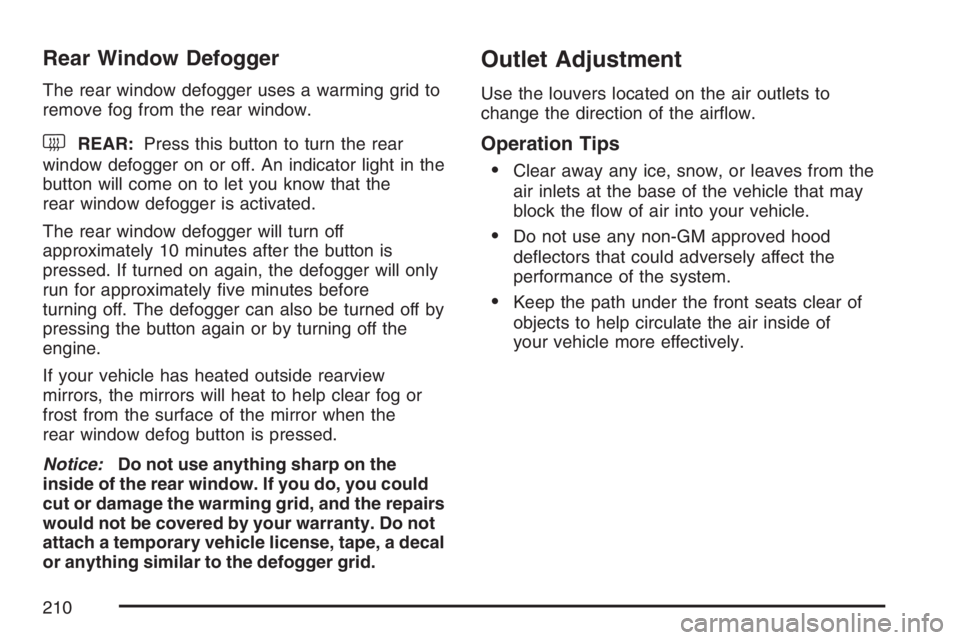
Rear Window Defogger
The rear window defogger uses a warming grid to
remove fog from the rear window.
button will come on to let you know that the
rear window defogger is activated.
The rear window defogger will turn off
approximately 10 minutes after the button is
pressed. If turned on again, the defogger will only
run for approximately �ve minutes before
turning off. The defogger can also be turned off by
pressing the button again or by turning off the
engine.
If your vehicle has heated outside rearview
mirrors, the mirrors will heat to help clear fog or
frost from the surface of the mirror when the
rear window defog button is pressed.
Notice:Do not use anything sharp on the
inside of the rear window. If you do, you could
cut or damage the warming grid, and the repairs
would not be covered by your warranty. Do not
attach a temporary vehicle license, tape, a decal
or anything similar to the defogger grid.
Outlet Adjustment
Use the louvers located on the air outlets to
change the direction of the air�ow.
Operation Tips
Clear away any ice, snow, or leaves from the
air inlets at the base of the vehicle that may
block the �ow of air into your vehicle.
Do not use any non-GM approved hood
de�ectors that could adversely affect the
performance of the system.
Keep the path under the front seats clear of
objects to help circulate the air inside of
your vehicle more effectively.
210
Page 211 of 528

Warning Lights, Gages, and
Indicators
This part describes the warning lights and gages
that may be on your vehicle. The pictures will
help you locate them.
Warning lights and gages can signal that
something is wrong before it becomes serious
enough to cause an expensive repair or
replacement. Paying attention to your warning
lights and gages could also save you or others
from injury.
Warning lights come on when there may be or is a
problem with one of your vehicle’s functions. As
you will see in the details on the next few
pages, some warning lights come on brie�y when
you start the engine just to let you know they
are working. If you are familiar with this section,
you should not be alarmed when this happens.Gages can indicate when there may be or is a
problem with one of your vehicle’s functions. Often
gages and warning lights work together to let you
know when there’s a problem with your vehicle.
When one of the warning lights comes on and
stays on when you are driving, or when one of the
gages shows there may be a problem, check
the section that tells you what to do about
it. Please follow this manual’s advice. Waiting to
do repairs can be costly – and even dangerous. So
please get to know your warning lights and
gages. They are a big help.
Your vehicle also has a message center that
works along with the warning lights and gages.
SeeMessage Center on page 225.
211